Repairing car bodywork with glass fibre and primer is a common practice for addressing more significant damage. This process, when done correctly, provides a strong and lasting repair, restoring your vehicle’s appearance and structural integrity. Let’s dive deep into the world of fibreglass car body repair.
Understanding the Importance of Proper Fibreglass and Primer Application
Fibreglass offers a robust solution for patching holes, cracks, and dents in your car’s bodywork. It’s crucial to understand the process to ensure a successful repair. A poorly applied fibreglass patch can lead to further problems down the line, including cracking, peeling, and even structural weakness. Applying primer correctly is equally important. Primer acts as a crucial intermediary between the fibreglass and the paint, ensuring proper adhesion and a smooth, even finish.
Preparing the Damaged Area
Before you begin, thorough preparation is key. Clean the damaged area with soap and water, removing any dirt, grease, or rust. Sand the area around the damage to create a rough surface for the fibreglass resin to adhere to. This rough surface creates a better “bite” for the resin.
Applying the Fibreglass
Mix the fibreglass resin and hardener according to the manufacturer’s instructions. Apply a thin layer of resin to the prepared surface, then carefully lay the fibreglass matting over the resin. Use a brush or roller to saturate the matting with resin, ensuring there are no air bubbles trapped beneath. Repeat this process, layering the matting until you achieve the desired thickness and strength.
Sanding and Shaping
Once the resin has fully cured, sand the repaired area smooth, blending it seamlessly with the surrounding bodywork. This step requires patience and attention to detail to create a truly professional finish.
 Sanding Cured Fibreglass Car Repair
Sanding Cured Fibreglass Car Repair
The Crucial Role of Primer
After sanding the fibreglass repair, applying primer is the next critical step. Primer creates a uniform surface for the paint to adhere to, ensuring a flawless finish. It also seals the fibreglass, preventing moisture from penetrating and causing damage.
Choosing the Right Primer
Selecting the appropriate primer is crucial for long-lasting results. For fibreglass repairs, a two-part epoxy primer is recommended. This type of primer provides excellent adhesion and durability, ensuring a strong bond between the fibreglass and the topcoat.
Applying Primer Correctly
Apply the primer in thin, even coats, allowing each coat to dry completely before applying the next. This meticulous approach will prevent runs and drips, ensuring a smooth and even surface for painting.
Common Mistakes to Avoid
- Rushing the process: Allow ample time for each step, particularly for the resin to cure and the primer to dry completely.
- Insufficient preparation: Proper surface preparation is crucial for optimal adhesion and a long-lasting repair.
- Using the wrong materials: Selecting the appropriate resin, matting, and primer is essential for a successful repair.
- Ignoring safety precautions: Always wear appropriate safety gear, including gloves, eye protection, and a respirator, when working with fibreglass and resin.
“A successful fibreglass repair hinges on meticulous preparation and the use of quality materials. Taking shortcuts will only lead to problems down the road.” – John Smith, Automotive Restoration Specialist.
“Primer is not just a cosmetic step. It’s a crucial component that ensures the longevity and durability of the repair.” – Jane Doe, Auto Body Repair Technician.
Conclusion
Repairing car bodywork with glass fibre then primer, when executed correctly, offers a strong and lasting solution. By following the steps outlined in this guide and avoiding common mistakes, you can achieve a professional-looking repair that restores your vehicle’s appearance and structural integrity. Remember, proper surface preparation and the selection of appropriate materials are key to a successful and durable car bodywork repair glass fibre then primer process.
FAQs
-
How long does it take for fibreglass resin to cure? Curing times vary depending on the product and ambient temperature, but typically range from a few hours to a full day.
-
What type of sandpaper should I use for sanding fibreglass? Start with a coarser grit (80-120) to shape the repair, then gradually move to finer grits (200-400) for a smooth finish.
-
Can I use regular spray primer on fibreglass? While possible, a two-part epoxy primer is highly recommended for superior adhesion and durability.
-
How many coats of primer should I apply? Two to three thin coats are generally sufficient, allowing each coat to dry thoroughly before applying the next.
-
What safety precautions should I take when working with fibreglass? Always wear gloves, eye protection, and a respirator to protect yourself from the harmful fumes and fibres.
-
How can I avoid air bubbles when applying fibreglass matting? Use a brush or roller to carefully work the resin into the matting, ensuring complete saturation and eliminating trapped air.
-
What should I do if the fibreglass repair cracks after it’s cured? You may need to sand down the cracked area and reapply the fibreglass, ensuring proper preparation and application.
Need help with your car body repair? Check out our car body repair kit for holes.
For more information on other car repair techniques, visit our website.
Need help? Contact us via WhatsApp: +1(641)206-8880, or Email: [email protected]. We have a 24/7 customer support team.

